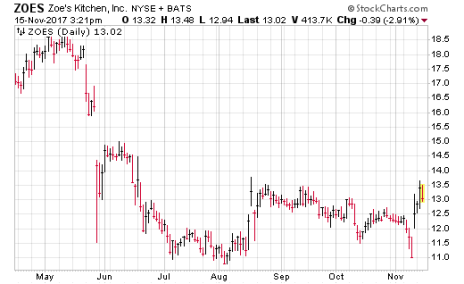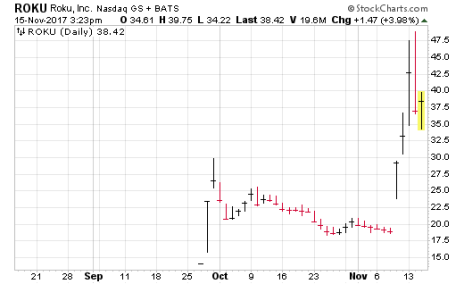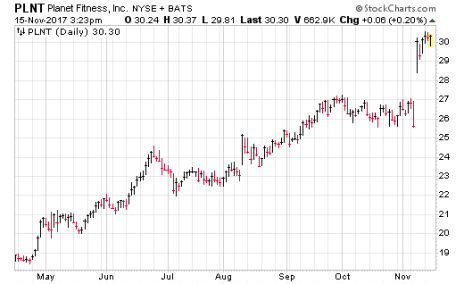In my last column, I reviewed the beginning of earnings season and how I interpret earnings reactions, and named three recent earnings winners that were worthy of your consideration. (Two of the three still look fine to me, and even Twitter (TWTR), which has pulled back, isn’t in overly rough shape.)
Today, though, I want to dive deeper than the “earnings gaps up are good, earnings gaps down are bad” analysis. That’s still true, but most of the questions I get concern in-between situations. It’s obvious that a 20% moonshot on earnings is great, while a 20% haircut is bad, but what about a 5% dip, followed by a quick recovery? Or vice versa? That’s what I address below (while presenting some more enticing opportunities).
Before I do that, I want to mention one thing that’s come up a few times recently: Whether you’re examining earnings season or trying to come up with some other rules/tools for your investing, remember not to make decisions based on just one or two examples. What you’re striving for is a REPEATABLE edge that consistently puts the odds in your favor.

Learn More

Learn More

Learn More

Learn More
So if you notice some sort of pattern, by all means investigate it (or email me for my thoughts) or keep a tally going forward to see if it repeats (which might mean it’s tradable). But don’t conclude that because the last two earnings gaps you bought failed (to pull an example out of thin air) that buying gaps is bad. That’s like saying that because the casino lost money one night that it has a flawed business model—you need to separate noise from what works over time.
OK, with that out of the way, let me dive into three more stocks that had different reactions this earnings season, what it means, and how (and if) to play them.
Three Q3 Earnings Season Reactions
1. A rise-from-the-dead situation, where a stock has been trending lower for months, is below all its intermediate- and longer-term moving averages and then BOOM, the stock gaps up in a big way on earnings.
Example: Zoe’s Kitchen (ZOES), which gapped up 14% on six times average volume last Friday and then rallied another 7% the first two days of this week. Even so, it never eclipsed its 200-day line and remained below resistance from earlier this year.
How to interpret it: When you see this sort of action—a dog of a stock shooting higher on earnings—I usually think of it as the beginning (or continuation) of a bottoming process. Sure, occasionally, these situations result in the stock marching straight higher, but that’s almost always because the market is doing the same (coming out of a big correction).
What to do: Watch it. In these situations, you’ll usually see a pullback after the gap and another few weeks (or longer, depending on the market) of bottom building. If ZOES is ready for a turnaround, I’d expect something similar, with an eventual push above 14 or so a possible green light.
2. A thinly traded and/or recent IPO goes bananas on earnings, surging to new highs, but also shows wild volatility.
Example: Roku (ROKU), the maker of smart TVs and devices, which had sagged after its IPO in late September but then soared more than 50% (!) on earnings last week and has continued to go up since.
How to interpret it: It’s certainly a bullish situation when you see this, and occasionally (not most of the time) it indicates a powerful new leading stock. That said, the volatility is hard to handle—ROKU has been trading in 10% to 25% ranges during the past few days!
What to do: There aren’t many hard-and-fast rules in a situation like this. On the one hand, I tend to wait for the stock to “grow up,” as institutions won’t usually be involved in a stock that’s showing this type of volatility. But, as I wrote above, these super-powerful moves in fundamentally strong recent issues can occasionally be the market’s way of telling you Roku stock is a new leader. Thus, you can nibble, but keep the position very small (maybe even less than half of your normal position size, dollar-wise) and use a very loose leash of 25% or so.
3. A stock sells off meaningfully for a day or two before earnings, only to shoot ahead following the report.
Example: Planet Fitness (PLNT), which had been moving sideways since early October, was stopped at resistance at 27 and dove to 25.5 (touching two-month lows in the process) the day ahead of earnings. Then it surged 17% the next day on nearly eight times volume, leaping to new highs.
How to interpret it: This is pretty much like a classic, big gap up on earnings, but with a shakeout thrown in before the report. To me, it’s very bullish and fits in well with my “shake and snap” pattern, where some weak hands were likely worn/scared out in the days ahead of earnings, leaving the strong hands to drive the stock up (and everyone else scrambling to buy back in).
What to do: Generally speaking, you can buy the stock on the gap. In PLNT’s case, it’s not really a go-go type of stock, so pullbacks of 50 cents or a point could be better bets, but in bull markets, I love the shakeouts followed by powerful, big trading volume recoveries, which is just what this is. Note that Arista Networks (ANET) displayed similar action recently, and it’s shot straight up since the gap.
There are a few more earnings gap variations I could go through (and maybe I will in a future column), but the past couple of columns should give you the rules to see and properly react to a bunch of different earnings season patterns.
Cabot Top Ten Trader features many momentum stocks that you could buy now, and the most recent issue has a few stocks that reacted well on earnings. To get the whole list, consider taking a subscription to Cabot Top Ten Trader.
Lastly, if you’re on Twitter, give me a follow @MikeCintolo. I usually tweet out a couple of stock market-related things each day (including stocks I’m watching or other interesting action).

Learn More

Learn More

Learn More

Learn More



